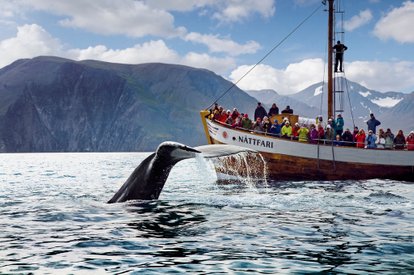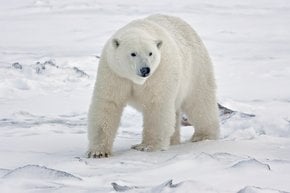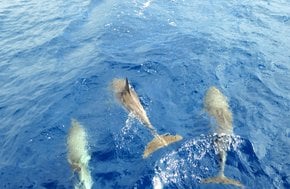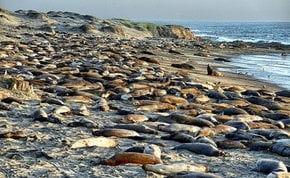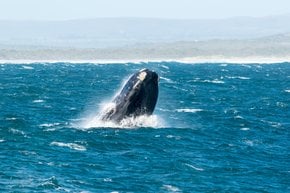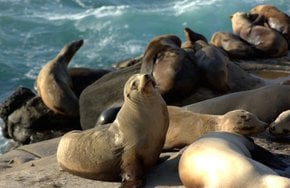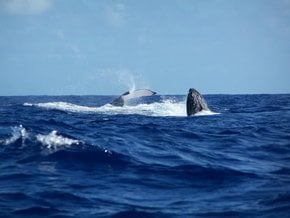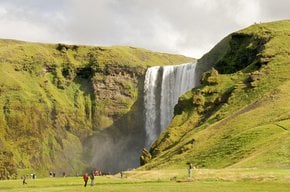Whale Watching in Iceland 2026
A tour of whale watching is fantastic because you can both enjoy sailing and see the whales in their natural habitat
Best time: April–October
Iceland is an ideal destination for whale watching, as its cold coastal waters are rich in marine life. The abundant fish in these waters attract various whale species, making it a must-see for any traveler. Tourists can embark on boat trips for an unforgettable adventure, experiencing the thrill of seeing these magnificent creatures up close in their natural habitat.
Best Season
The preferable time to embark on whale watching expedition in Iceland is between April to October. As during these months, diverse kinds of whales come closer to the shores to feed on fish. June to August is a peak period for sighting, as the sea is serene and the days are long, making it easier to spot the whales. However, note that spot varies with each tour and depends on the luck of the day.
Best Viewing Locations
The city of Húsavík is a paradise for whale enthusiasts, renowned for its abundant marine life. As a pioneer in whale watching, Húsavík attracts visitors seeking unforgettable experiences. Tourists can explore Húsavík's whale museum, as the city is regarded as one of the world's whale capitals. In addition to Húsavík, there are excellent whale-watching opportunities from other locations, such as Reykjavík, Akureyri, and Ólafsvík. Akureyri, the second-largest city in Iceland, offers numerous tours, while Hauganes specializes in tailored experiences. Ólafsvík, located on the Snæfellsnes Peninsula, provides chances to spot orcas and humpback whales.
Whale Watching Tours
Whale-watching excursions are widely available throughout Iceland, with daily tours departing from the Old Harbour in Reykjavík and various towns in the west and north. Húsavík whale watching tours typically last about two and a half hours, allowing for adjustments based on the whales' locations. The first part of the tour takes visitors to feeding spots for whale viewing from a safe distance. Given the cold and unpredictable sea conditions, it's advisable to dress warmly, as there are only heated indoor observation areas on the boats. Tour operators also provide complimentary coffee or tea to enhance the experience.
Other Marine Animals to See
In addition to whales, marine animals like seals, puffins, and dolphins can be spotted on tours in Iceland. Puffins are best viewed during their breeding season between May and June on coastal islands. Sightings depend on timing and luck, but the chance to see these creatures makes the tour an unforgettable experience. Iceland's diverse marine life offers visitors the opportunity to witness the beauty of its oceans firsthand, contributing to the trip's lasting memories.
Endangered Status of Whale Population
Visitors can feel grateful for the opportunity to witness magnificent whales in their natural habitat, especially given their previous endangered status due to centuries of hunting. Thankfully, the cessation of these practices has led to a remarkable recovery in whale populations, particularly among minke whales.
Whale-Watching Tips
Despite the whales' massive size and their presence near shallow beaches, whale watching remains a safe activity as long as an appropriate distance is maintained. It is particularly true when observing from boats, where spectators often struggle to contain their excitement and are eager to witness the unique bond between mothers and their calves, which lasts until the young are weaned after about a year. For optimal visibility, try to secure a seat at the bow of the boat. If you are prone to motion sickness, it's best to choose a larger, more stable vessel.
What to Wear
Even on hot days, ocean temperatures can be significantly cooler, so it’s wise to bring a windbreaker or at least a sweater. Opt for long pants and closed-toed shoes with non-slip rubber soles for better comfort and safety. Additionally, protect yourself from harmful UV rays by wearing sunscreen, a sunhat, and sunglasses during your sea adventure.
What to Bring
Bring binoculars and a camera with a telephoto lens to enhance your chances of spotting and photographing sea mammals. Don’t forget to pack extra batteries. Given the likelihood of splashes, especially on small boats or kayaks, consider using a waterproof sleeve or zip bag to protect your phone and photo gear. While packing snacks is not essential, as many large catamarans and sailboats provide food and beverages onboard, smaller boats typically offer a basic supply of water for the tour.
Photography Tips
Taking a great whale photo requires patience and quick reflexes. Watch for signs like diving birds, which often signal feeding whales. Focus on areas with bird activity, as the whale may surface suddenly. For shots of breaching or tail flukes, look for a whale arching its back—this usually means it's about to dive. Breaching is harder to predict, but if it happens once, it might happen again. Use a wide-angle lens for ocean scenery and a shorter lens for action shots, as it's easier to track the whale.



